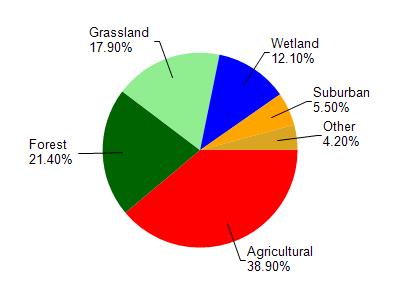Sheboygan
Yes
No
No
Fish and Aquatic Life
Overview
Jackson Creek originates from a spring area in the northeast quarter of section 20. The stream flows northeasterly, crossing Highway 23, through a small marsh, and eventually draining into the Mullet River. In 1978 the stream was downgraded from a Class I trout stream to a Class II for its entire length. Increased silt entering the stream and the resulting impacts were responsible for the classification change. The silt comes from poor erosion control practices related to the construction of a housing subdivision and an industrial park northwest of the city of Plymouth. There is also concern that two abandoned gravel pits located in sections 17 and 20 of the town of Plymouth may be contributing to the pollutant load of the creek. The DNR owns 20 acres of land bordering a tributary to Jackson creek in the town of Plymouth T15N R21E S17. Fish and stream habitat surveys in 2001 rated good, and the benthic macroinvertebrate community rated excellent.
JACKSON CREEK - T15N R21E Sec. 16, Stream Length = 1.8 miles.
From: Galarneau, Steve and Masterson, John. 1999. Water Resources of the Sheboygan River Basin. Wisconsin Department of Natural Resources, Madison, WI.
Date 1999
Author Aquatic Biologist
Condition
Wisconsin has over 84,000 miles of streams, 15,000 lakes and milllions of acres of wetlands. Assessing the condition of this vast amount of water is challenging. The state's water monitoring program uses a media-based, cross-program approach to analyze water condition. An updated monitoring strategy (2015-2020) is now available. Compliance with Clean Water Act fishable, swimmable standards are located in the Executive Summary of Water Condition in 2018. See also the 'monitoring and projects' tab.
Recommendations
Monitor Targeted Area
Water quality biologists should conduct a stream assessment on Jackson Creek.
Management Goals
Wisconsin's Water Quality Standards provide qualitative and quantitative goals for waters that are protective of Fishable, Swimmable conditions [Learn more]. Waters that do not meet water quality standards are considered impaired and restoration actions are planned and carried out until the water is once again fishable and swimmable
Management goals can include creation or implementation of a Total Maximum Daily Load analysis, a Nine Key Element Plan, or other restoration work, education and outreach and more. If specific recommendations exist for this water, they will be displayed below online.
Monitoring
Monitoring the condition of a river, stream, or lake includes gathering physical, chemical, biological, and habitat data. Comprehensive studies often gather all these parameters in great detail, while lighter assessment events will involve sampling physical, chemical and biological data such as macroinvertebrates. Aquatic macroinvertebrates and fish communities integrate watershed or catchment condition, providing great insight into overall ecosystem health. Chemical and habitat parameters tell researchers more about human induced problems including contaminated runoff, point source dischargers, or habitat issues that foster or limit the potential of aquatic communities to thrive in a given area. Wisconsin's Water Monitoring Strategy was recenty updated.
Grants and Management Projects
Monitoring Projects
| WBIC | Official Waterbody Name | Station ID | Station Name | Earliest Fieldwork Date | Latest Fieldwork Date | View Station | View Data |
|---|
| 54700 | Jackson Creek | 10008214 | Jackson Creek - Jackson Creek 10 M Upstream Of Cth C | 11/28/2001 | 11/28/2001 | Map | Data |
|

Watershed Characteristics
Jackson Creek is located in the Mullet River watershed which is 88.19 mi². Land use in the watershed is primarily agricultural (38.90%), forest (21.40%) and a mix of grassland (17.90%) and other uses (21.80%). This watershed has 97.54 stream miles, 789.87 lake acres and 6,609.38 wetland acres.
Nonpoint Source Characteristics
This watershed is ranked High for runoff impacts on streams, Not Ranked for runoff impacts on lakes and High for runoff impacts on groundwater and therefore has an overall rank of High. This value can be used in ranking the watershed or individual waterbodies for grant funding under state and county programs.However, all waters are affected by diffuse pollutant sources regardless of initial water quality. Applications for specific runoff projects under state or county grant programs may be pursued. For more information, go to surface water program grants.